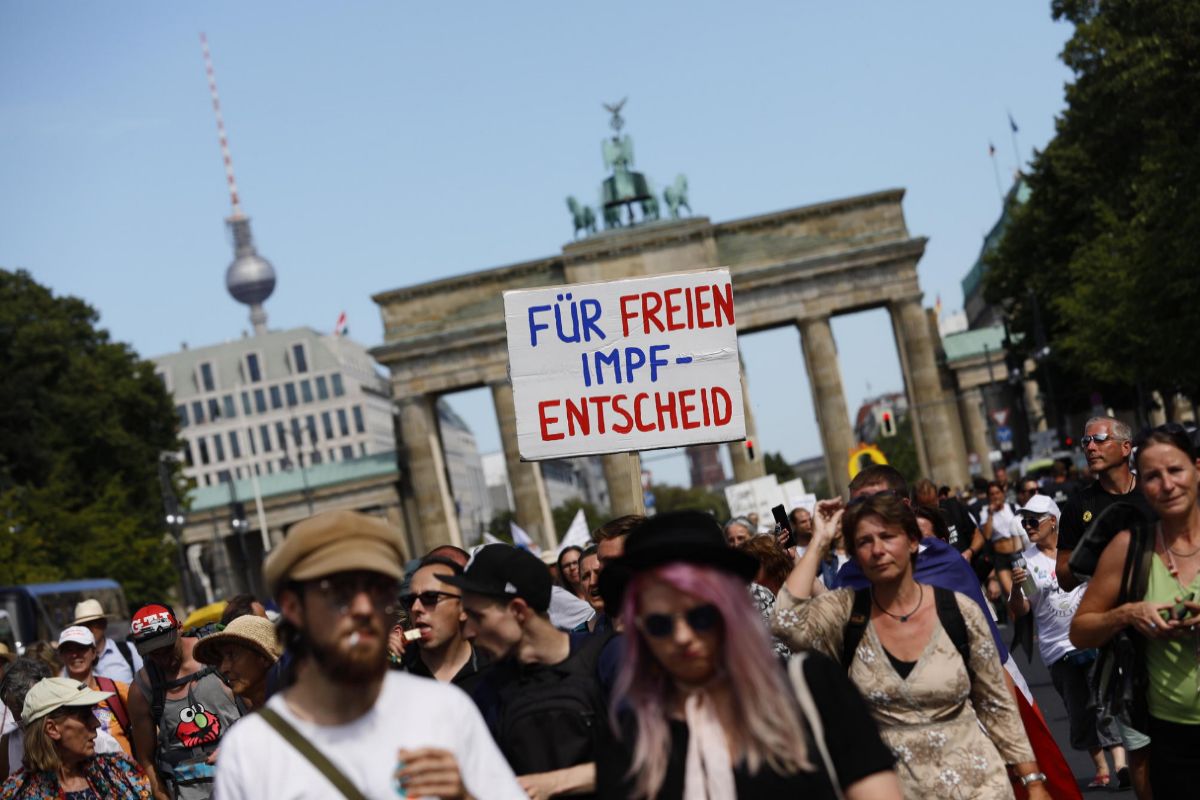- Direct - the latest news from the coronavirus
- 100 days later: winners and losers in the fight against the coronavirus pandemic
Thousands of protesters, including conspiranoids, far-rightists and advocates that restrictions violate individual freedom, marched through Berlin proclaiming the end of the pandemic amid a spike in contagion across the country.
The march, called as "Freedom Day", ran through the vicinity of the Brandenburg Gate amid slogans against the "Angela Merkel tyranny" and its alleged allies, the pharmaceutical industry and US billionaire Bill Gates.
It was disarmed before reaching its target, the Victory Column, in the heart of the capital, amid tensions between the police and the conveners. Hardly anyone respected physical distancing, let alone used the mask, despite this being one of the conditions imposed by the authorities to authorize the march.
The demonstration then morphed into dozens of dispersed groups willing to focus anyway on the Column, while others headed for alternative targets, such as the Foreign Ministry headquarters.
Some 17,000 protesters came to gather, according to regional public television RBB, among whom, in addition to conspiranoids and ultras, were ordinary citizens or merchants unhappy with the restrictions on public life.
The mere fact of adopting as a common slogan the reference to "Freedom Day" betrayed a far-right interest in the call. It is the title of the 1935 Nazi Party Congress film directed by Leni Riefelstahl, the filmmaker who worked in the service of Adolf Hitler's propaganda apparatus.
The Berlin authorities deployed a strong security device ; In addition to this mobilization, about twenty demonstrations had been called this Saturday, including three of a leftist nature against the march of the denialists.
To the deployment for this type of political demonstrations are added other police devices aimed at avoiding problems of public order in the face of the increasing number of "spontaneous" parties that have been taking place in the German capital for weeks.
They are open-air parties or picnics, which bring together thousands of participants. The authorities show a certain tolerance, as they are escape valves for youth entertainment while clubs and discotheques remain closed. Some end in riots, such as those generated a few weeks ago in Frankfurt or Stuttgard.
Domestic or imported infections
The demonstration for the end of the restrictions also comes at a time of great concern between the federal government of Chancellor Angela Merkel and the regional powers over the increase in new infections.
According to data from the Robert Koch Institut (RKI), in the last 24 hours there were 955 new infections - the highest since May and a touch of alert compared to between 800 and 850 a week ago or between 300 and 350 in the middle of June-. The total count of infections verified since the start of the pandemic is 209,653, with 9,148 fatalities and 192,700 patients recovered.
The rebound is seen in practically the entire country; Mass infections are usually derived from family gatherings, festivals, or religious ceremonies. Fear also increases that the so-called "imported contagions" will skyrocket with the return home of those who vacationed outside the country.
Germany offers free tests to travelers returning from abroad from this Saturday, tests that will be mandatory starting Monday for those who come from risky regions. Until now, these were in house quarantine, but their compliance was, in practice, difficult to follow.
Those from areas not included in that list have 72 hours to voluntarily go to medical consultations or other centers, where they will also be tested free of charge.
According to indications from the Minister of Health, Jens Spahn, the rule is in effect this Saturday, who defends that these tests are free against criticism from those who consider that they should be paid by the traveler so as not to overload public health.
Among the risk areas since yesterday there are three Spanish regions -Catalonia, Navarra and Aragon- in addition to Luxembourg, the only country in the European Union (EU) that was already included in the list of the Robert Koch Institut (RKI). The rest are third countries in the Balkans, as well as Turkey, the United States, practically all of Latin America, and large areas of Africa and Asia.
According to the criteria of The Trust Project
Know more- Angela Merkel
- Berlin
- Turkey
- European Union
- Africa
- Adolf Hitler
- Germany
- Aragon
- Asia
- Catalonia
- U.S
- Coronavirus
- Covid 19
Coronavirus Germany includes Catalonia, Aragon and Navarra in "risk areas" for coronavirus after the increase in outbreaks
SaludCoronavirus Spain today, last minute live | Aragon registers 89 active outbreaks, 41 in residences and 32 in jobs
CoronavirusGermany discourages its citizens from traveling to Catalonia, Aragon and Navarra
See links of interest
- News
- Programming
- Translator
- Calendar
- Horoscope
- Classification
- League calendar
- Films
- Themes

